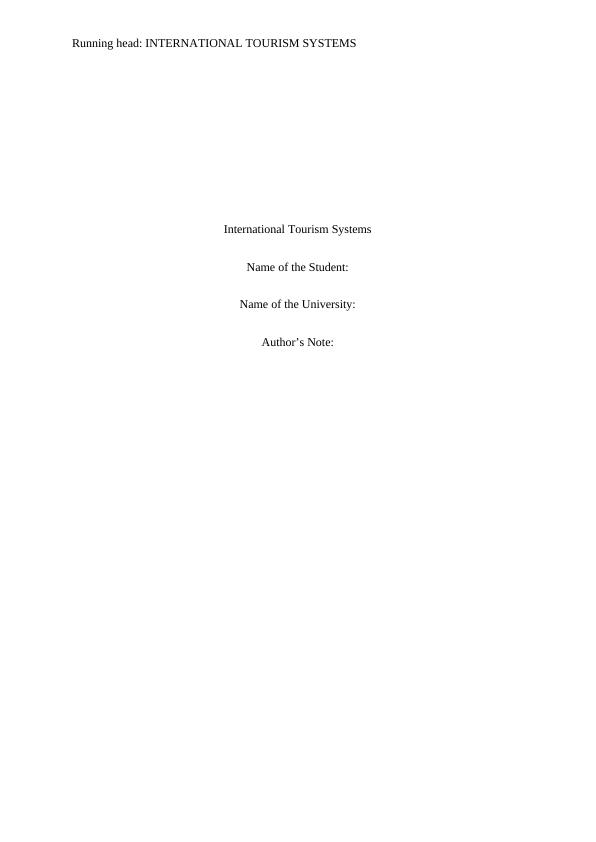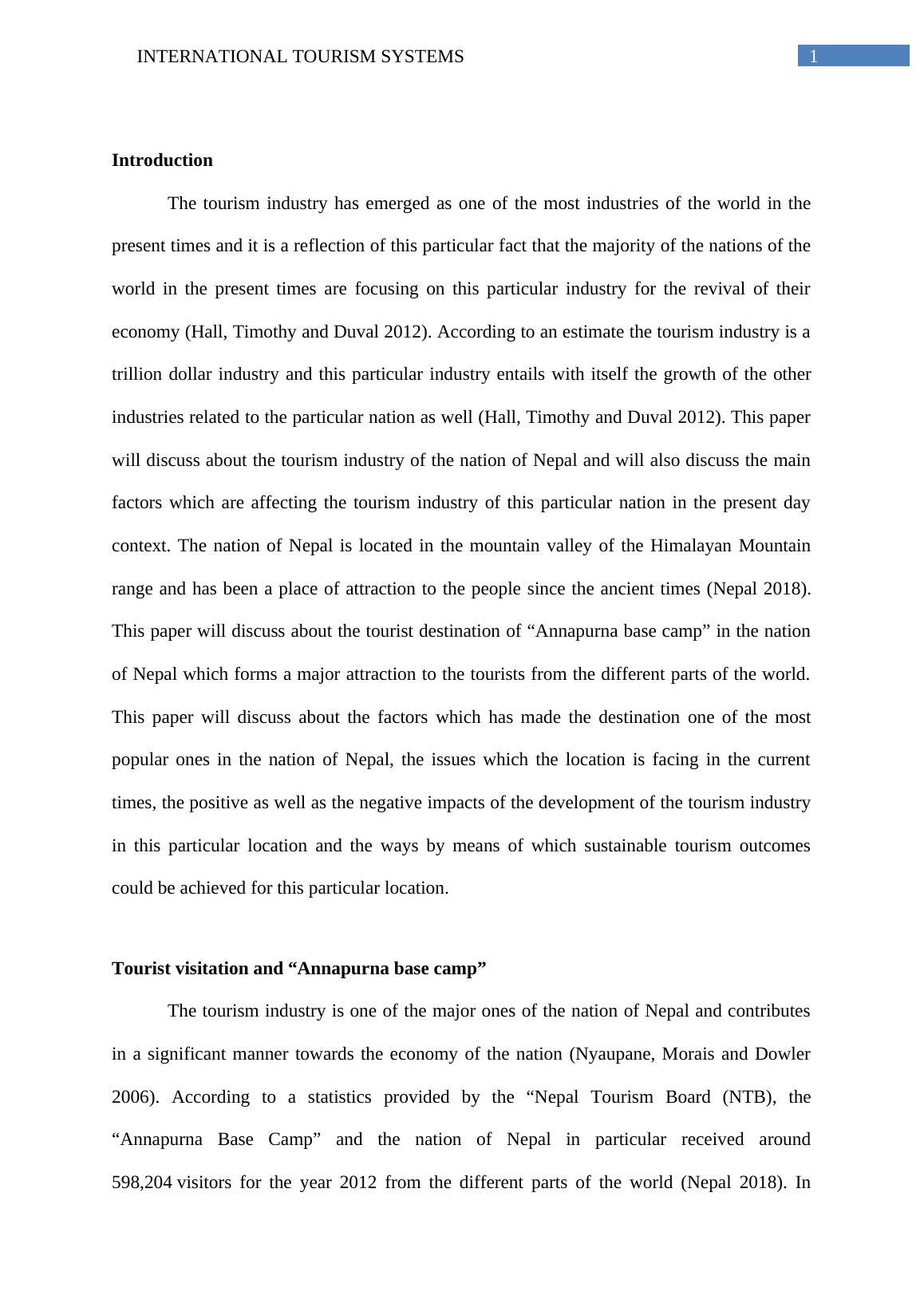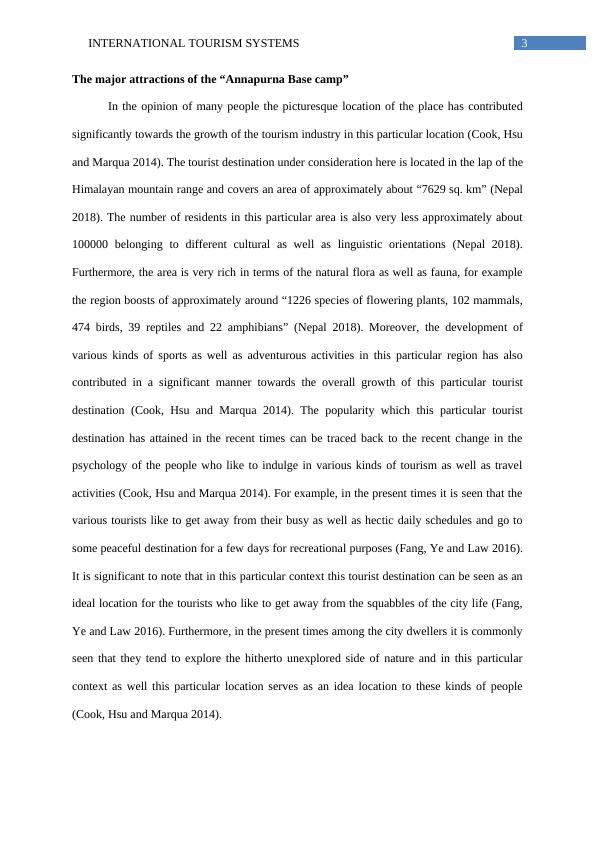International Tourism Systems
11 Pages3407 Words95 Views
Added on 2021-05-31
International Tourism Systems
Added on 2021-05-31
ShareRelated Documents
Running head: INTERNATIONAL TOURISM SYSTEMSInternational Tourism SystemsName of the Student:Name of the University:Author’s Note:

1INTERNATIONAL TOURISM SYSTEMSIntroductionThe tourism industry has emerged as one of the most industries of the world in thepresent times and it is a reflection of this particular fact that the majority of the nations of theworld in the present times are focusing on this particular industry for the revival of theireconomy (Hall, Timothy and Duval 2012). According to an estimate the tourism industry is atrillion dollar industry and this particular industry entails with itself the growth of the otherindustries related to the particular nation as well (Hall, Timothy and Duval 2012). This paperwill discuss about the tourism industry of the nation of Nepal and will also discuss the mainfactors which are affecting the tourism industry of this particular nation in the present daycontext. The nation of Nepal is located in the mountain valley of the Himalayan Mountainrange and has been a place of attraction to the people since the ancient times (Nepal 2018).This paper will discuss about the tourist destination of “Annapurna base camp” in the nationof Nepal which forms a major attraction to the tourists from the different parts of the world.This paper will discuss about the factors which has made the destination one of the mostpopular ones in the nation of Nepal, the issues which the location is facing in the currenttimes, the positive as well as the negative impacts of the development of the tourism industryin this particular location and the ways by means of which sustainable tourism outcomescould be achieved for this particular location.Tourist visitation and “Annapurna base camp” The tourism industry is one of the major ones of the nation of Nepal and contributesin a significant manner towards the economy of the nation (Nyaupane, Morais and Dowler2006). According to a statistics provided by the “Nepal Tourism Board (NTB), the“Annapurna Base Camp” and the nation of Nepal in particular received around598,204visitors for the year 2012 from the different parts of the world (Nepal 2018). In

2INTERNATIONAL TOURISM SYSTEMSaddition to this, it is generally seen that the tourists from the various different parts of theworld on an average spend around “11.78 days” in the nation of Nepal and for the“Annapurna Base Camp” it is even more on the score of the wide range of activities as wellas the other attractions which this particular destination provides to the tourists from thedifferent parts of the world (Nepal 2018). It is a reflection of this particular fact that theannual contribution of the tourism industry towards the national economy of the nation ofNepal for the year 2014 was more than $471m (Nepal 2018). Therefore, to celebrate thecontribution made by the tourism industry towards the national economy the nation of Nepaldeclared the year 2011 to be the “Nepal Tourism Year” which further boosted the tourismindustry of the nation attracted many more tourists to the nation (Nepal 2018). Furthermore,the “Annapurna Base Camp” receives the maximum number of tourists from the continent ofAsia itself which is around 55.9% (Nepal 2018). Furthermore, the various businessorganizations related to the tourism industry in this particular area normally offers 11 day or14 day trekking package to the tourists from the different parts of the world (Nepal 2018). Inthe opinion of many scholars this particular base camp has been able to attract a large ofnumber of tourists from the different parts of the world on the score of various factors like thenatural beauty of the location, the feasibility of adventurous sports at this particular location,the trekking facilities which tourists get at this particular location, the natural isolation of thisparticular destination which is located in the lap of the Himalayan mountain range(Nyaupane, Morais and Dowler 2006). It is significant to note that these factors havecontributed in a significant manner towards the boom of the tourism industry in this particularregion (Nyaupane, Morais and Dowler 2006).

3INTERNATIONAL TOURISM SYSTEMSThe major attractions of the “Annapurna Base camp”In the opinion of many people the picturesque location of the place has contributedsignificantly towards the growth of the tourism industry in this particular location (Cook, Hsuand Marqua 2014). The tourist destination under consideration here is located in the lap of theHimalayan mountain range and covers an area of approximately about “7629 sq. km” (Nepal2018). The number of residents in this particular area is also very less approximately about100000 belonging to different cultural as well as linguistic orientations (Nepal 2018).Furthermore, the area is very rich in terms of the natural flora as well as fauna, for examplethe region boosts of approximately around “1226 species of flowering plants, 102 mammals,474 birds, 39 reptiles and 22 amphibians” (Nepal 2018). Moreover, the development ofvarious kinds of sports as well as adventurous activities in this particular region has alsocontributed in a significant manner towards the overall growth of this particular touristdestination (Cook, Hsu and Marqua 2014). The popularity which this particular touristdestination has attained in the recent times can be traced back to the recent change in thepsychology of the people who like to indulge in various kinds of tourism as well as travelactivities (Cook, Hsu and Marqua 2014). For example, in the present times it is seen that thevarious tourists like to get away from their busy as well as hectic daily schedules and go tosome peaceful destination for a few days for recreational purposes (Fang, Ye and Law 2016).It is significant to note that in this particular context this tourist destination can be seen as anideal location for the tourists who like to get away from the squabbles of the city life (Fang,Ye and Law 2016). Furthermore, in the present times among the city dwellers it is commonlyseen that they tend to explore the hitherto unexplored side of nature and in this particularcontext as well this particular location serves as an idea location to these kinds of people(Cook, Hsu and Marqua 2014).

End of preview
Want to access all the pages? Upload your documents or become a member.
Related Documents
International Tourism Systemlg...
|5
|905
|40
Case Study about Pokhara 2022lg...
|15
|3455
|23
Destination Management Serviceslg...
|14
|4265
|58
Factors Affecting Travel and Tourism Industry: A Comparative Analysis of Kenya and Nepallg...
|11
|917
|203
International Tourism Management Nepallg...
|12
|3190
|106
International Tourism System Assignment Reportlg...
|12
|4017
|20
